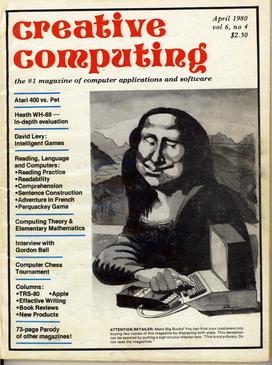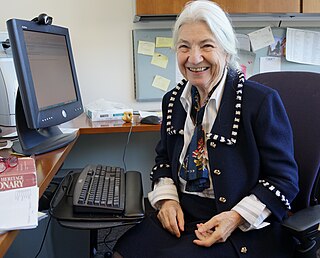
Computer magazines are about computers and related subjects, such as networking and the Internet. Most computer magazines offer (or offered) advice, some offer programming tutorials, reviews of the latest technologies, and advertisements.

Computer magazines are about computers and related subjects, such as networking and the Internet. Most computer magazines offer (or offered) advice, some offer programming tutorials, reviews of the latest technologies, and advertisements.
Sources:. [1]
In the 1980s, computer magazines skewed their content towards the hobbyist end of the then-microcomputer market, and used to contain type-in programs, but these have gone out of fashion. The first magazine devoted to this class of computers was Creative Computing . Byte was an influential technical journal that published until the 1990s.
In 1983, an average of one new computer magazine appeared each week. [18] By late that year more than 200 existed. Their numbers and size grew rapidly with the industry they covered, and BYTE and 80 Micro were among the three thickest magazines of any kind per issue. [19] Compute! 's editor in chief reported in the December 1983 issue that "all of our previous records are being broken: largest number of pages, largest-number of four-color advertising pages, largest number of printing pages, and the largest number of editorial pages". [20]
Computers were the only industry with product-specific magazines, like 80 Micro, PC Magazine , and Macworld ; their editors vowed to impartially cover their computers whether or not doing so hurt their readers' and advertisers' market, while claiming that their rivals pandered to advertisers by only publishing positive news. [21]
BYTE, in March 1984, apologized for publishing articles by authors with promotional material for companies without describing them as such, and in April suggested that other magazines adopt its rules of conduct for writers, such as prohibiting employees from accepting gifts or discounts.
InfoWorld stated in June that many of the "150 or so" industry magazines published articles without clearly identifying authors' affiliations and conflicts of interest.
Around 1985, many magazines ended. However, as their number exceeded the amount of available advertising revenue despite revenue in the first half of the year five times that of the same period in 1982. Consumers typically bought computer magazines more for advertising than articles, which benefited already leading journals like BYTE and PC Magazine and hurt weaker ones. Also affecting magazines was the computer industry's economic difficulties, including the video game crash of 1983, which badly hurt the home-computer market.
Dan Gutman, the founder of Computer Games, recalled in 1987 that "the computer games industry crashed and burned like a bad night of Flight Simulator —with my magazine on the runway". Antic 's advertising sales declined by 50% in 90 days, Compute!'s number of pages declined from 392 in December 1983 to 160 ten months later, and Compute! and Compute!'s Gazette 's publisher assured readers in an editorial that his company "is and continues to be quite successful ... even during these particularly difficult times in the industry". Computer Gaming World stated in 1988 that it was the only one of the 18 color magazines that covered computer games in 1983 to survive the crash. Compute! similarly stated that year that it was the only general-interest survivor of about 150 consumer-computing magazines published in 1983.
Some computer magazines in the 1980s and 1990s were issued only on disk (or cassette tape, or CD-ROM) with no printed counterpart; such publications are collectively (though somewhat inaccurately) known as disk magazines and are listed separately.
In some ways, the heyday of printed computer magazines was a period during the 1990s. During this period, a large number of computer manufacturers took out advertisements in computer magazines, so they became quite thick and could afford to carry quite a number of articles in each issue. Computer Shopper was a good example of this trend.
Some printed computer magazines used to include covermount floppy disks, CDs, or other media as inserts; they typically contained software, demos, and electronic versions of the print issue.
However, with the rise in popularity of the Internet, many computer magazines went bankrupt or transitioned to an online-only existence. Exceptions include Wired , which is more of a technology magazine than a computer magazine.
| Name | Occupation | Magazines (years of regular contributions) |
|---|---|---|
| | Programmer | Unix Review (1980s–1990s) |
| | TV comedian, TV reviewer, newspaper columnist | PC Zone (1990s) |
| | Science fiction author | Ahoy! , Compute! |
| | Game designer | BYTE , Computer Gaming World |
| | Paralegal, legal blogger | Linux User , others |
| | Writer, consultant, programmer, songwriter | UNIX Review (1984–2000), OS/2 Magazine, Software Development |
| | Professor, investor | Wired magazine (1993–1998) |
| | Science fiction author | BYTE (1980–2006) |
| | Game scriptwriter, journalist | PC Zone |
| | Security specialist, writer, cryptographer | Wired magazine |
| | Science fiction and fantasy author | Computer Shopper (UK magazine) (1994–2004) |
| | Writer, consultant, programmer | Dr. Dobb's Journal, Byte, etc. |
The Association for Computing Machinery (ACM) is a US-based international learned society for computing. It was founded in 1947 and is the world's largest scientific and educational computing society. The ACM is a non-profit professional membership group, reporting nearly 110,000 student and professional members as of 2022. Its headquarters are in New York City.

SIGGRAPH is an annual conference centered around computer graphics organized by ACM, starting in 1974 in Boulder, CO. The main conference is usually held in North America though is not limited in location possibilities; SIGGRAPH Asia, a second conference held annually, has been held since 2008 in countries throughout Asia.
Joseph Frank Ossanna, Jr. was an American electrical engineer and computer programmer who worked as a member of the technical staff at the Bell Telephone Laboratories in Murray Hill, New Jersey. He became actively engaged in the software design of Multics, a general-purpose operating system used at Bell.
Communications of the ACM is the monthly journal of the Association for Computing Machinery (ACM). It was established in 1958, with Saul Rosen as its first managing editor. It is sent to all ACM members. Articles are intended for readers with backgrounds in all areas of computer science and information systems. The focus is on the practical implications of advances in information technology and associated management issues; ACM also publishes a variety of more theoretical journals. The magazine straddles the boundary of a science magazine, trade magazine, and a scientific journal. While the content is subject to peer review, the articles published are often summaries of research that may also be published elsewhere. Material published must be accessible and relevant to a broad readership.

Ben Shneiderman is an American computer scientist, a Distinguished University Professor in the University of Maryland Department of Computer Science, which is part of the University of Maryland College of Computer, Mathematical, and Natural Sciences at the University of Maryland, College Park, and the founding director (1983-2000) of the University of Maryland Human-Computer Interaction Lab. He conducted fundamental research in the field of human–computer interaction, developing new ideas, methods, and tools such as the direct manipulation interface, and his eight rules of design.

Creative Computing was one of the earliest magazines covering the microcomputer revolution. Published from October 1974 until December 1985, the magazine covered the spectrum of hobbyist/home/personal computing in a more accessible format than the rather technically oriented Byte.
Edmund Callis Berkeley was an American computer scientist who co-founded the Association for Computing Machinery (ACM) in 1947. His 1949 book Giant Brains, or Machines That Think popularized cognitive images of early computers. He was also a social activist who worked to achieve conditions that might minimize the threat of nuclear war.

The Design Automation Conference, or DAC, is an annual event, a combination of a technical conference and a trade show, both specializing in electronic design automation (EDA).
SIGDA, Association for Computing Machinery's Special Interest Group on Design Automation, is a professional development organization for the Electronic Design Automation (EDA) community. SIGDA is organized and operated exclusively for educational, scientific, and technical purposes in electronic design automation. SIGDA's bylaws were approved in 1969, following the charter of SIC in Design Automation in 1965.
ACM Transactions on Graphics (TOG) is a bimonthly peer-reviewed scientific journal that covers the field of computer graphics.
Thomas Albert "Tom" DeFanti is an American computer graphics researcher and pioneer. His work has ranged from early computer animation, to scientific visualization, virtual reality, and grid computing. He is a distinguished professor of Computer Science at the University of Illinois at Chicago, and a research scientist at the California Institute for Telecommunications and Information Technology (Calit2).

Rodnay Zaks is a French-born American author of many books on computer programming, including the seminal Programming the Z80 and Programming the 6502. He is the founder of independent computer book publisher Sybex and was its president and chief executive officer (CEO) until its takeover by John Wiley & Sons in May 2005.
Randy Howard Katz is an American computer scientist. He is a distinguished professor emeritus at University of California, Berkeley of the electrical engineering and computer science department.
ACM SIGACCESS is the Association for Computing Machinery's Special Interest Group on accessible computing, an interdisciplinary group of academic and industrial researchers, clinicians and rehabilitation personnel, policy makers, end users, and students to develop technologies for use by people with disabilities.

Ruzena Bajcsy is an American engineer and computer scientist who specializes in robotics. She is professor of electrical engineering and computer sciences at the University of California, Berkeley, where she is also director emerita of CITRIS.
Bruce Gilchrist is considered one of the notable figures in modern computing history.
The American Federation of Information Processing Societies (AFIPS) was an umbrella organization of professional societies established on May 10, 1961, and dissolved in 1990. Its mission was to advance knowledge in the field of information science, and to represent its member societies in international forums.

Byte was a microcomputer magazine, influential in the late 1970s and throughout the 1980s because of its wide-ranging editorial coverage.
The Joint Computer Conferences were a series of computer conferences in the United States held under various names between 1951 and 1987. The conferences were the venue for presentations and papers representing "cumulative work in the [computer] field."
Venkata Narayana Padmanabhan is a computer scientist and principal researcher at Microsoft Research India. He is known for his research in networked and mobile systems. He is an elected fellow of the Indian National Academy of Engineering, Institute of Electrical and Electronics Engineers and the Association for Computing Machinery. The Council of Scientific and Industrial Research, the apex agency of the Government of India for scientific research, awarded him the Shanti Swarup Bhatnagar Prize for Science and Technology, one of the highest Indian science awards for his contributions to Engineering Sciences in 2016.
{{cite journal}}: Cite journal requires |journal= (help){{cite book}}: |last= has generic name (help)Claims to be "the first hobby-computer publication in the world."